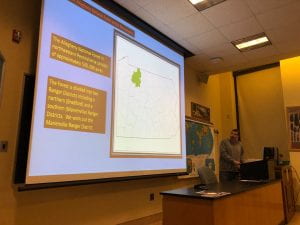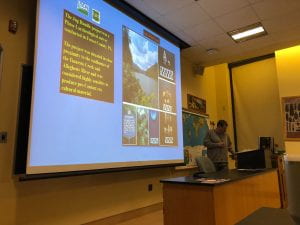On March 8th we had two special guests join us for our first Graduate Colloquium of the semester. Mr. Andrew Myers, MA, RPA and Patricia Stahlman, MS, visited to present and discuss Cultural Resource Management on the Allegheny National Forest in 2023. They sent bios which are below, so you can better understand who they are and what they do.

Mr. Andrew Myers, MA, RPA is an archaeologist with the USDA Forest Service stationed out of the Marienville Ranger District in western Pennsylvania. He began his archaeological career in 1982 working for Dr. Stanley Lantz of the Carnegie Museum at the multicomponent Penelec (36WA152) site located near Warren, Pennsylvania. It was during this time he learned excavation technique at a Late Paleoindian though Contact period site that was also the location of a stockade Mead Island tradition village. During his career he has worked on numerous projects throughout the Mid-Atlantic region before returning to the Forest Service in 2017. His research interests include Late Woodland ceramics and has extensively studied Glaciated Allegheny Plateau (GAP) tradition archaeology with an interest in the McFate phase (circa. AD 1400-1590).
Patricia Stahlman, MS has over 20 years of experience in cultural resource management, much of that with the Forest Service. During her time on the Allegheny National Forest she has managed Section 106 compliance projects covering thousands of acres of federal lands and recorded and/or investigated hundreds of cultural sites. Projects have included Phase I surveys, Phase II evaluations, and Phase III data recovery. Patricia’s research interests include the history and pre-history of the Upper Ohio River Valley, particularly within the Clarion River and Tionesta Creek drainage basins.
To summarize, the presentation provided an overview of the cultural resource management program effected on the Marienville Ranger District of the Allegheny National Forest (ANF). Any ground disturbing activity is subject to federal law which dictates agencies must take into account the effects of their actions on historic properties. Each year in response to a host of projects including timber sales, oil and gas development, and recreation, varying degrees of archaeological investigation are implemented including surveys, evaluations, and data recovery. Recent projects conducted on the District that were discussed included two Phase I block surveys and a Phase III data recovery project held at a Civil War era house site. At the end of the presentation a discussion on obtaining federal jobs was also presented for students preparing to enter the workforce.
The presentation also covered the legal framework that goes into working for the Forest Service, how a project gets started, predictive modeling, large block surveys, what a Phase I survey and types finds in the Allegheny Forest would look like, along with how sites might be located, followed by examples of recent projects they are currently working on, and finished with a discussion on opportunities with the Forest Service. My favorite part was when Mr. Myers talked about site indicators and what the remnants of a historical site could look like if one does not know if one is there; such as a random opening in a forest, the presence of apple trees, or heirloom flowers which could potentially the remains of a historic garden near a former house site. Students were able to get a taste of what working for the Allegheny National Forest is like, and they were able to make connections with those who have been involved in it for years. We are so grateful that we had the opportunity to learn from and discuss with Myers and Stahlman about the important work they are doing within the Forest Service.
Follow IUP Anthropology on Facebook, Twitter, and Instagram